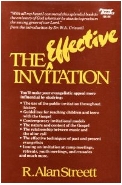The Effective Invitation. By R. Alan Streett. Old Tappan, NJ: Fleming H. Revell Company, 1984. 252 pp. Paper, $6.95.
For those who believe the evangelistic invitation has a legitimate and important use in Christian preaching, there has long been the need for a helpful book. Streett’s work could be that book, if one is willing to forgive some theological loose ends.
Any book on the sensitive subject of the evangelistic invitation will incite disagreement over theology and method because cherished theological convictions and tradition are at stake. Streett’s work is not theologically exacting and the reader may detect a bias towards the traditional Southern Baptist altar call (when he wrote the book, Streett was Professor of Evangelism and New Testament at Criswell Bible College in Dallas, Texas), but the book nevertheless has its broader value.
Streett begins with a discussion of the Gospel and other theological concerns, then attempts to support the public invitation from Scripture, tracing the historical use of the invitation, and answering criticisms about the invitation. Though the title suggests a “how to” book, only one-fourth of the book is devoted to practical suggestions.
The other sections have their value, however. Theological issues are important, and history always adds helpful perspective. One most interesting and valuable chapter is “Billy Graham’s Use of the Public Invitation” where the reader is allowed a profitable inside glimpse and analysis of this celebrated evangelist’s use of the public invitation. Also, criticisms commonly leveled at the public invitation are ably answered in chapter six. Chapter seven argues convincingly for the use of a public invitation. Nevertheless, a caveat is in order here; that is to say, this reviewer believes Streett has taken some questionable liberties in finding public invitations in the Scriptures and in the history of evangelism (as also in chapters three and four).
However, those in the mainstream of GES may be less than satisfied with Streett’s first chapter, “Tell Me, What Is the Gospel?” At the outset, the reader gets the impression that Streett recognizes the free offer of salvation: “No one can work for or earn his salvation. It is a free, unmerited gift …” (p. 32). Still, one wonders why he quotes a proponent of Lordship Salvation on the Lordship of Christ (pp. 29–30). This reviewer is also confused by such statements as, “Until the hearer believes the facts of the gospel and receives Jesus Christ as his own personal Lord and Savior, the gospel message offers no hope for salvation” (p. 33). It is not that Streett presents an unacceptable view of the Gospel; on the contrary, he lacks clarity on a foundational issue that determines one’s understanding and use of the public invitation.
His section on repentance may also raise questions, although many will find his view acceptable. Streett suggests that repentance “signifies the willful inward change of mind, not an initial outward action. The sinner must be transformed inside-out, not vice versa” (p. 41). He views repentance as a synonym for faith so that they are two sides of the same coin (p. 46). The question arises, however, in his application of the doctrine of repentance to Gospel preaching today. On account of the examples of John the Baptist and the Lord Jesus Christ in the Gospels, and Peter in Acts, the author feels that the preaching of repentance must receive due emphasis in the present generation (pp. 43–44). But it is a bit careless to equate the evangelistic invitation today with that in the Gospels and the early chapters of Acts without acknowledging dispensational differences between the invitation to God’s covenant people, Israel, and the “other sheep. ” He also answers those who say that the absence of the mention of repentance in salvation-related passages (in particular, the Gospel of John, which never mentions it) should restrain the preaching of repentance in modern evangelistic preaching. His answer that faith and repentance are synonyms and therefore deserve equal emphasis does not answer the biblical evidence satisfactorily (p. 46).
Streett also places undue emphasis on the public nature of confession. He says that a person who truly believes “will willingly make a confession of the fact” (p. 72). The problem is that confession is equated only with a public display: “A heart full of faith will express itself in a public witness. A faith that does not produce an open confession is not a saving faith” (p. 73). However, many would rather allow a new believer to confess Christ in more reserved ways than through the cultural altar call which Streett seems to favor. Furthermore, what constitutes a confession is a source of debate. Streett does not explain why, according to his view, baptism alone does not suffice.
These theological snags should not keep one from profiting from the practical aspects of the book. Contained within are balanced insights for preparing and delivering invitations, and helpful suggestions for the use of different kinds of invitations, the use of music, and inviting children to trust in Christ. Above all, Streett is to be commended for promoting integrity and opposing fleshly manipulation which uses undue pressure tactics in invitations.
If one has already resolved the theological issues relating to the invitation, this book can be used to great profit. It will surely be worth the price for those who are privileged to preach the Gospel and desire to do so more effectively.
Charles C. Bing
Editorial Board
Journal of the Grace Evangelical Society
Burleson, TX

